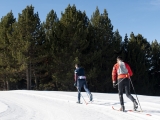The mention of the Grand Zebrú will make the eyes of those who have read Kurt Diemberger's 0 to 8,000 Meters shine. For fans of adventure sports the mountain skiing you will not be indifferent to knowing that these valleys have come from and that ski stars usually train here.
The history buff will be chilled by finding fortifications at 3,500 m, a reminder of the First World War. The rest of us will also find good reasons to do this itinerary, such as the possibility of accessing a terrain full of three miles with excellent snow cover, with optimal slopes for skiing in Italy and surrounded by a good network of refuges, with an excellent Italian atmosphere.

Two and a half days will be enough for an average skier to climb two of the most characteristic peaks of the Orales-Cevedale: one is the Grande Zebra or Königspitze (3,859 m), depending on whether it is named from the Italian Valfurva or from the Sulden Valley ( Solda), Germanic speaking. The other is Cevedale, with its two nearby points of 3,778 m and 3,766 m. And if you have time, the Pizzo Tressero, the San Matteo, the Monte Pasquale, the Palon de la Mare or the Rosole on the one hand, or the alpine ski resorts and cross-country ski resorts of Santa Caterina Valfurva or Bormio, will be a good reason to extend your stay in the area.
The region is frequented by local mountain skiers from nearby regions and neighboring countries, so we will easily find trails along most of the route. It is advisable to ask the guards about the status of the described itineraries or their variants.
Starting point: Forni Refuge (2,178 m). Recommended access: Through Milan, Lecco, Bormio and Santa Caterina Valfurva. (1,737 m). From there a paved road leads to the Forni refuge.
1st Stage: Forni Refuge (2,178 m) - Pizzini Refuge (2,706 m) with a slope of 530 m
From the refuge take a NNE direction and ascend through open terrain following traces to the Pizzini refuge. Variant: The day can be completed with the ascent of Monte Pasquale (3,559 m) via the Vedretta (glacier) of Cedec, ascending to the Pasquale pass (3,431 m) and then to the summit. We must inform ourselves at the refuge about the state of the glacier.

2nd Stage: Pizzini Refuge (2,706 m) -Grand Zebrú (3,859 m) with a difference in altitude: 1,153 m
The Grand Zebrú is the emblematic peak of the region, so its ascent has great prestige. We will ascend through open terrain to the foot of the corridor that leads to the Bottiglia Pass (bottle). From there, continue on foot along the corridor to the pass (3,295 m) and then ascend the ESE face of Grand Zebrú to the summit, marked by a large cross. The descent is done via the uphill route.
In good conditions it is feasible to descend on skis from the top. The section under the summit has a slope of 45º for about 40 m, with the next 550 m having a variable slope between 35º to 40º and the corridor from 40º to 45º. The risk is high on the ESE face, as it is cut by a gap of 300 meters, scarce for the runner.
3rd Stage: Pizzini Refuge (2,706 m) - Mt Cevedale (3,778 m) with an elevation gain: 1,072 m
From the refuge we will leave in the direction of the Cevedale pass (3,266 m), where we will arrive after overcoming somewhat steep slopes facing west, to continue to the nearby Casati refuge (3,268 m). From there you ascend in a SE direction towards the pass between the two points of Cevedale. From the pass you can climb to the main point (3,778 m) and then, along an easy but aerial ridge, to Cevedale NE (3,766 m).
Cevedale is an impressive viewpoint over the entire Alps and from its summit you can see Montblanc or the Austrian GrossGlockner, as well as most of the intermediate massifs. Descent: follow the uphill route to the Pizzini refuge and then towards Forni, where we will find the car.

Variant: it is possible to descend from Monte Cevedale through the Vedretta (glacier) of Cedec and thus arrive directly at the Pizzini refuge. This itinerary is somewhat less frequented and the glacier has important cracks.












